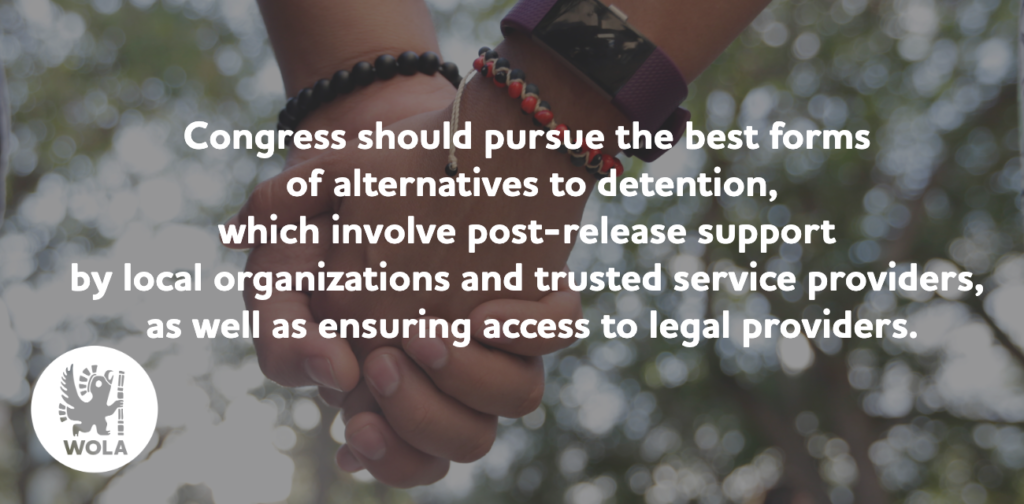(AP Photo/Daniel Ochoa de Olza)
(AP Photo/Daniel Ochoa de Olza)
The deadline for Congress to pass appropriations bills is fast approaching—and the most contentious funding bill set to be negotiated is the Department of Homeland Security (DHS) 2020 budget. As congressional leaders begin negotiations this month, WOLA looks at six critical points of debate and sets forth recommendations that not only reflect good policy, but respect the human dignity and rights of migrants.
Over the past two years, Congress has rejected the president’s insistent attempts to build a border-wide wall along the U.S.-Mexico border. In late 2018 and early 2019, much of the U.S. government shut down as President Trump refused to sign a budget that did not include $5.7 billion in wall-building money. Congress would not pass a budget with that funding in it, and eventually Trump relented—but on February 15, he issued a legally dubious “national emergency” proclamation pulling over $6 billion from the Department of Defense budget and the U.S. Treasury’s seized assets funds.
For 2020, the Senate’s bill offers $5 billion for additional pedestrian fencing at the border. On the other hand, the House’s version of the DHS appropriations bill states that no federal funds may be used for construction of physical barriers along the southern border. The House also seeks to rescind over $600 million in prior years’ wall-building funds.
WOLA’s position:
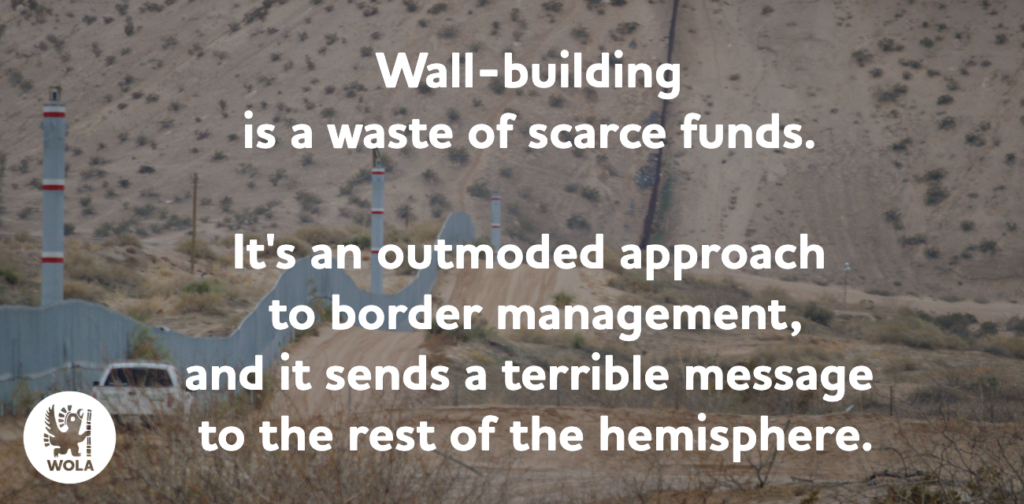
A partial exception is a few densely populated border zones where undocumented crossers could quickly “vanish” without a barrier to slow them down for a few minutes—but nearly all such zones already have extensive fencing. Walls do not stop cross-border drug trafficking: well over 80 percent of all border-zone seizures of heroin, fentanyl, methamphetamine, and cocaine occur at the border’s 45 understaffed and underfunded official ports of entry, not the areas between them where walls would be built.
Walls are also useless in deterring the population that continues to arrive at our southern border: about two-thirds of all apprehended migrants in 2019 were asylum-seeking families, mostly from Central American countries. They do not attempt to evade capture when voluntarily turning themselves in to Border Patrol agents or arriving at ports of entry to await “metering” into the country. Their goal is to exercise their right to seek protection upon setting foot on U.S. soil. At fenced land borders, that requires them to climb the fence and wait. At riverine borders, they cross the Rio Grande and wait on the riverbank on the U.S. side, south of the “wall” but firmly on U.S. soil.
Given the serious humanitarian crisis at the border, investments that address systemic drivers of migration from Central America are smarter than an expensive and ineffective border-wide barrier. In order to have a serious discussion about how to secure the border from actual threats like drug trafficking and human smuggling, DHS should prioritize cost effective and rights-respecting modernized technology, particularly at ports of entry. This year’s budget should incorporate the House language to prevent a harmful waste of public funds on the border.
Immigration and Customs Enforcement (ICE) has been spending far more than Congress has appropriated for the detention of migrants. This is chiefly due to the Trump administration’s increased roundups of non-criminal aliens in the interior, and a near-total refusal to release single adult asylum seekers while they await their hearings. “The administration’s increasing defiance of congressional intent, as expressed in appropriated funding levels, cannot continue,” warns the House Appropriations Committee’s narrative report for the 2020 bill.
The 2020 House bill would provide funding for 34,000 single adult beds to accommodate detained migrants, about 10,000 beds fewer than were funded in 2019. The very different Senate version funds 52,161 beds, 6,887 more than last year. Both chambers recognize that the Trump administration has been overspending its appropriated ICE funding to detain more migrants than intended by Congress. In an attempt to rein in the Trump administration’s use of transfer authority among DHS agencies to gradually increase ICE’s capacity to detain migrants, the House offered limitations in the 2020 bill. Amendments were offered in the Senate to do the same, but ultimately were not included in the final version of the bill.
WOLA’s position:
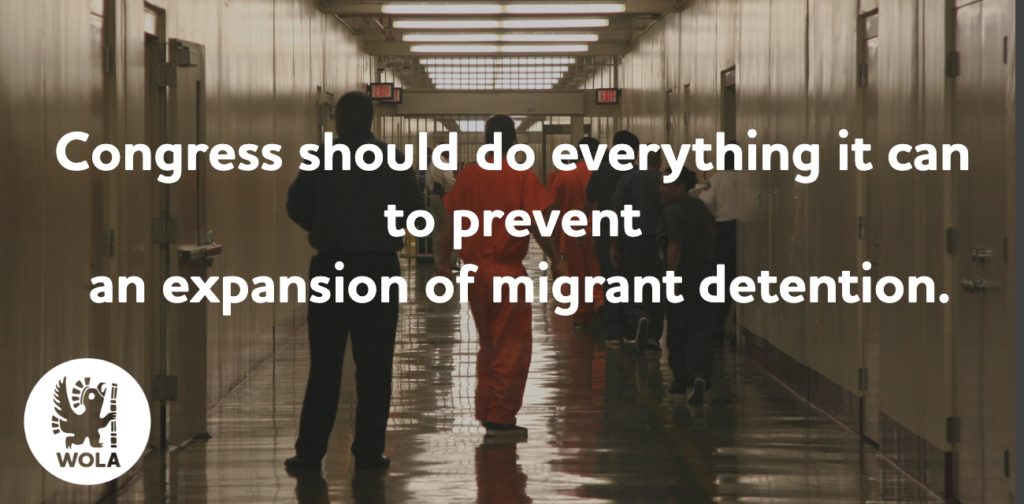
This especially includes more comprehensive implementation of “alternatives to detention” programs, which ensure high compliance rates with immigration proceedings at a fraction of the cost of detention. The House version gives Trump fewer resources to ramp up detention and acknowledges that the Trump administration is likely to use “life and safety” or other exceptions to evade appropriated limits on numbers of detention beds. Therefore, Congress should incorporate the House language.
The Trump administration announced in December 2018 that it would roll out a policy in which asylum seekers arriving at the border would be sent back to Mexican border cities to wait out their asylum proceedings. This program, officially known as “Migrant Protection Protocols (MPP)” but more commonly called “Remain in Mexico,” was expanded after President Trump’s May 2019 threat to impose tariffs on Mexican goods if Mexico did not crack down harder on migration.
Today, “Remain in Mexico” has sent more than 50,000 Central Americans, Cubans, and other asylum-seeking migrants, homeless and at times threatened, to six Mexican border cities. MPP is the direct cause of over 200 documented assaults, abuses, and kidnappings of asylum seekers participating in the program. Numerous human rights groups from across the region have denounced the program, documenting lack of access to legal services, procedural deficiencies in the way the program is carried out, and extremely unsafe conditions for migrants regularly targeted in Mexico.
The House bill would require that the DHS Secretary submit a report to Congress outlining specific plans the department would take to (1) ensure access to legal counsel for those returned to Mexico, (2) develop a plan with the State Department to address safety and security needs of those enrolled, (3) ensure that individuals enrolled in the program are adequately briefed on their legal rights once returned to Mexico, (4) develop a plan with the Department of Justice to prioritize proceedings of those in the program, and (5) create policy documents that identify vulnerable individuals who should not be returned, such as pregnant women and the LGBT community.
WOLA’s position: The House mandated report would be a welcome and important step. However:
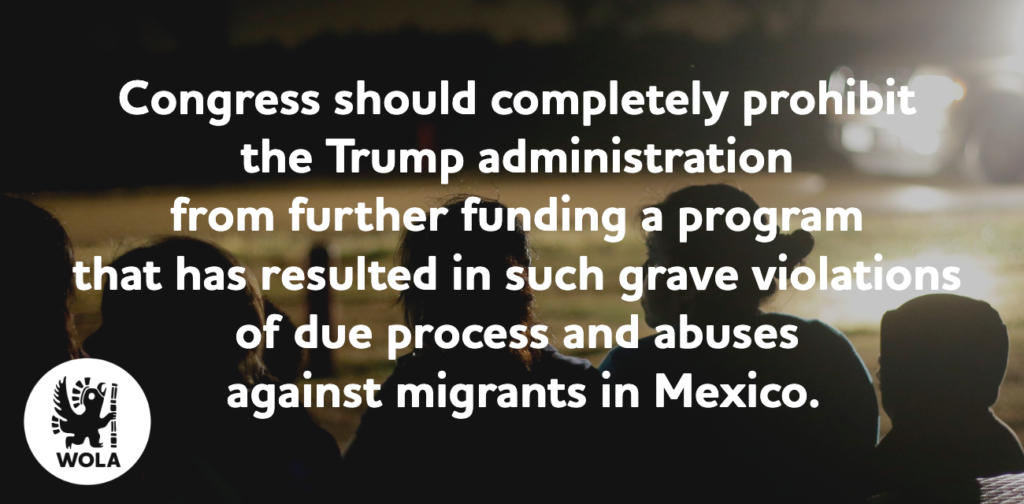
“Remain in Mexico” should be either halted outright or rapidly phased out. We hope that the Ninth Circuit Court of Appeals, which is currently reviewing the policy, concurs.
Upon taking office in 2017, President Trump issued an executive order calling for the hiring of 5,000 new Border Patrol agents, which would have represented a one-quarter increase in a force that has already quintupled in size since the early 1990s. Both houses of Congress have been unwilling to fund this, as Border Patrol has been largely unable to overcome staffing attrition and maintain itself at currently funded levels. Both House and Senate appropriations bills reject the president’s request to hire more Border Patrol agents to be stationed between ports of entry. Instead, both bills would provide funding to hire an additional 200 technicians who would assist with operational support.
Hiring technicians to support with transportation and other activities that are outside of the purview of regular border patrol duties could help return 160 Border Patrol agents to their positions on the border, according to the Senate Appropriations Committee’s narrative report on the DHS budget bill.
WOLA’s Position:

In all of 2018, the average Border Patrol agent apprehended 14 single adults—one every 3.7 weeks—and 10 children or parents who sought to be apprehended. If staffing levels remained similar in 2019, the average Border Patrol agent apprehended 18 single adults—one every 2.9 weeks— and had to process 33 children or parents.
The numbers argue for increased personnel to process asylum-seeking children and families who seek to be apprehended, not more Border Patrol agents. Additional hiring is needed instead at the ports of entry, where staffing shortages contribute to long border crossing wait times, poor capacity to process asylum seekers, and limited interdiction of drug smuggling.
Since May 2018, CBP has pursued a border-wide practice of “metering”: stationing officers on the borderline to restrict the number of asylum-seekers who may approach ports of entry to seek protection.
The result has been burgeoning number of migrants, many facing serious threats, forced to register themselves on informal waitlists in Mexican border cities, where they may spend weeks or months waiting their turn to seek refuge. Metering incentivizes asylum seekers to cross illegally between ports of entry, to give up their asylum claims and return to potentially dangerous situations at home, or to wait in precarious conditions in Mexico.
Both the House and Senate versions of the 2020 DHS appropriations bills request monitoring of how metering is being implemented. The Senate bill would provide Congress with a monthly in-depth report on the number of asylum seekers processed at each port of entry, the number of those turned away, rationale for metering at each port, capacity constraints, recommendations for alleviating these constraints, and any agreement made between U.S. and Mexican authorities.
WOLA’s Position:
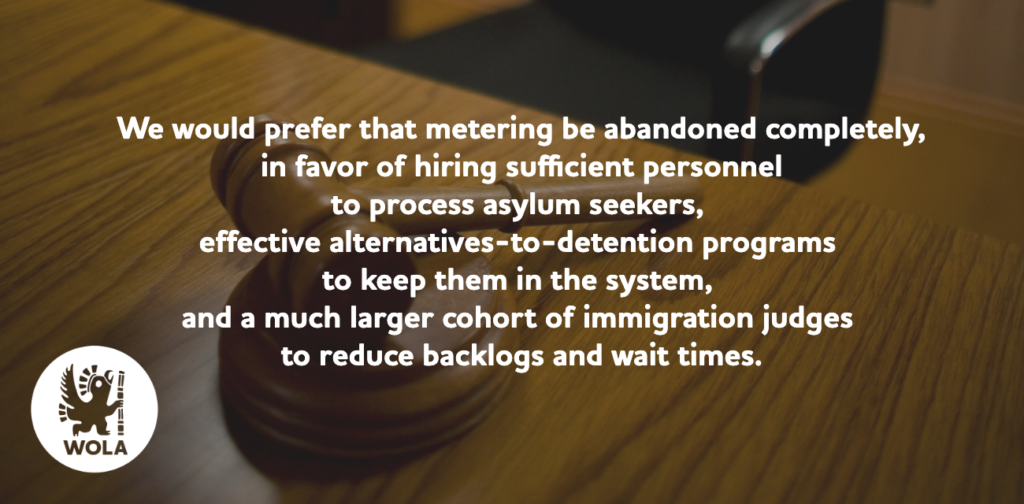
Neither bill seeks to curtail metering. We support the report required in the Senate bill, as it would be extremely useful to advocates who need better visibility on what is happening, as well as to shelters that work directly with migrants.
Only the Flores court settlement prevents the Trump administration from detaining asylum-seeking parents and children while their asylum claims are adjudicated. But mass detention is unnecessary: alternatives to detention (ATD) programs have been shown in pilot testing to be far more humane, effective, and less expensive.
The U.S. government can avoid the unnecessary, prolonged detention of migrant families, which is never in the best interest of children, by using other measures that ensure that asylum-seeking families show up for their court appearances. An example is the ICE Family Case Management Program, which released families into the interior with frequent contact from caseworkers, achieving a 96 percent compliance rate at a cost of about $38 per family per day—until the Trump administration halted it in 2017.
Both the House and Senate appropriations bills provide increased funding for alternatives to detention (ATDs), as well as require performance reports on the effectiveness of these programs. The House bill provides slightly more than the Senate ($344 million) to grow the ATD program and reinstate the Family Case Management Program.
WOLA’s Position: We support the House language on ATDs. Additionally:
